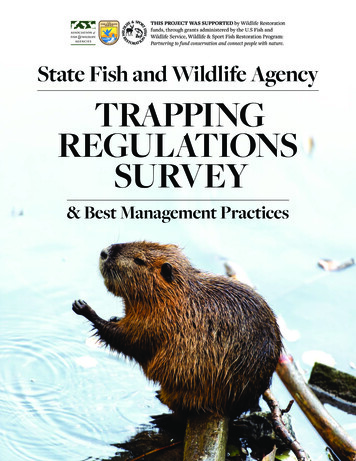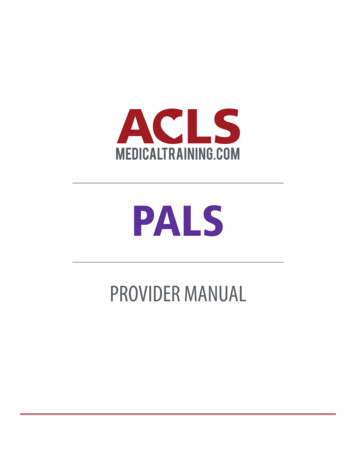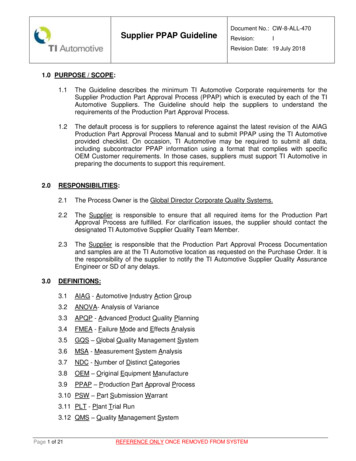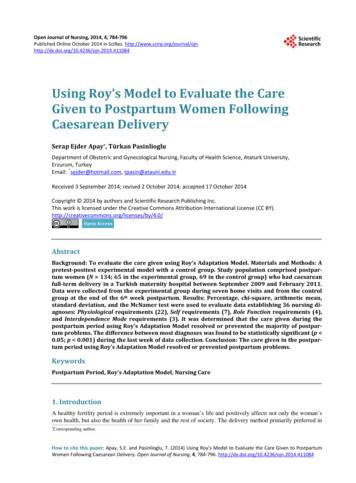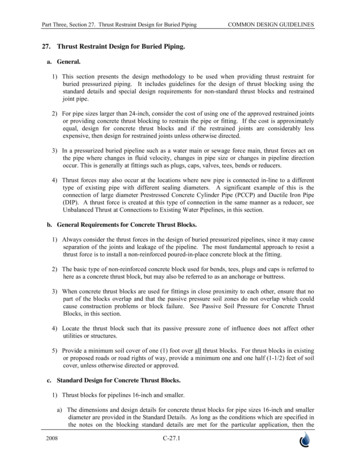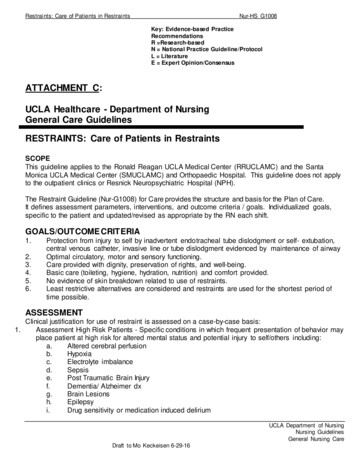
Transcription
Restraints: Care of Patients in RestraintsNur-HS G1008Key: Evidence-based PracticeRecommendationsR Research-basedN National Practice Guideline/ProtocolL LiteratureE Expert Opinion/ConsensusATTACHMENT C:UCLA Healthcare - Department of NursingGeneral Care GuidelinesRESTRAINTS: Care of Patients in RestraintsSCOPEThis guideline applies to the Ronald Reagan UCLA Medical Center (RRUCLAMC) and the SantaMonica UCLA Medical Center (SMUCLAMC) and Orthopaedic Hospital. This guideline does not applyto the outpatient clinics or Resnick Neuropsychiatric Hospital (NPH).The Restraint Guideline (Nur-G1008) for Care provides the structure and basis for the Plan of Care.It defines assessment parameters, interventions, and outcome criteria / goals. Individualized goals,specific to the patient and updated/revised as appropriate by the RN each shift.GOALS/OUTCOME CRITERIA1.2.3.4.5.6.Protection from injury to self by inadvertent endotracheal tube dislodgment or self- extubation,central venous catheter, invasive line or tube dislodgment evidenced by maintenance of airwayOptimal circulatory, motor and sensory functioning.Care provided with dignity, preservation of rights, and well-being.Basic care (toileting, hygiene, hydration, nutrition) and comfort provided.No evidence of skin breakdown related to use of restraints.Least restrictive alternatives are considered and restraints are used for the shortest period oftime possible.ASSESSMENT1.Clinical justification for use of restraint is assessed on a case-by-case basis:Assessment High Risk Patients - Specific conditions in which frequent presentation of behavior mayplace patient at high risk for altered mental status and potential injury to self/others including:a.Altered cerebral perfusionb.Hypoxiac.Electrolyte imbalanced.Sepsise.Post Traumatic Brain Injuryf.Dementia/ Alzheimer dxg.Brain Lesionsh.Epilepsyi.Drug sensitivity or medication induced deliriumUCLA Department of NursingNursing GuidelinesGeneral Nursing CareDraft to Mo Keckeisen 6-29-16
Restraints: Care of Patients in Restraints2.Nur-HS G1008j.Alcohol / Recreational Drug ingestionk.Encephalopathyl.Post AnesthesiaSpecific procedures in which restraints may be necessary to prevent harm to the patient wheneffectiveness of procedure is compromised and endangers the patient such as:a.Emergent Intubationb.Insertion of invasive cathetersc.Magnetic Resonance Imaging (MRI), Computed Tomography (CT) Scans, AngiographyproceduresUSE OF LESS RESTRICTIVE MEASURES PRIOR TO INSTITUTING RESTRAINTSNote: An individualized approach to care is the best way to avoid use of restraints for patients withacute confusion and cognitive impairment. R1Consider the following alternative measures before implementing Restraints: L1, L2Alternatives Measures include: (See Appendix B) Hand Mittens (unrestrained) Activity Apron Body Holder Support Device (Bed or Chair) Bed Check Monitoring Device or Bed Alarms *Elbow Immobilizer (Freedom Splints) / *No-No’s in Pediatrics (these devices while “less restrictive”meet the definition of a restraints and require MD Restraint Order).Physiologic Measures Comfort measures Positioning/back massage Pain/Anxiety Relief Ensure patient is clean & dry Toileting Routinely (offer urinal) Check for hunger/thirstPsychological Measures Frequent reorientation to person, time, place with verbal redirection Soothing music, therapeutic relaxation techniques, Urban Zen Diversional activities: exercises, TV/Music, play therapy Companionship/Supervision: family in room, constant observational aide, Keep patient well informed and allow active participation in careEnvironmental/Safety Measures: Consider noise, lighting in room Relocate patient near nursing station Security in proximity (e.g. ER setting) Frequent checks for environmental/patient safetyUCLA Department of NursingNursing GuidelinesGeneral Nursing CareDraft to Mo Keckeisen 6-29-16
Restraints: Care of Patients in RestraintsNur-HS G1008INTERVENTIONS:Non-Violent (Medical-Surgical) Restraints:Non-violent restraints are used when alternatives and least restrictive methods have been ineffective toprevent injury and exhibit due to accidental dislodgment of invasive-central lines, tubes or drains,hypoxia, electrolyte/metabolic imbalance, dementia, encephalopathy, drug sensitivity, or sepsis.a.Agitation Level 1 or 2 (See Agitation Scale)a.Pulling/Tugging at invasive gnitive impairment affecting safety judgmentd.Wandering behavior w/ impaired safety judgmentAgitation Scale 3 Immediate threat to safety 2 Agitated, does not calm to verbal 1 Agitated, calms to verbal0 Calm, follows commands 3Immediateto2. Notify the MD, NP, or PA, as soon as possible (withinthreat2 hours)and obtain restraint order. Thesafetyorder must be entered into EMR within the 2 hour time frameofinitialrestraint application. 2Agitated,3. Non-violent (medical/surgical) restraint orders can never written as PRN or as ‘Standing Orders’.not calm4. Vital signs are monitored and physical assessmentdoesdocumented(including respiratory andto verbalcardiac status) per nursing guidelines of care or more frequentlyas indicated or ordered1Agitated,5. Notify the physician, NP, or PA immediately for a significantchange in patient condition.calmsto6. Renewal orders for ongoing restraints are required eachcalendarday.verbal5. New restraint orders are required upon patient transfers toanotherunitor service, upon transfer to0 Calm,followsanother level of care (e.g. ICU to floor) upon examination of the patient by physician, NP, or PA.commandsFlowsheet Documentation - Non-Violent (Medical-Surgical) Restraint:UCLA Department of NursingNursing GuidelinesGeneral Nursing CareDraft to Mo Keckeisen 6-29-16
Restraints: Care of Patients in RestraintsNur-HS G1008 A (P) mark (Q2 hours – row 1) indicates observation and monitoring of patient forpresence of injury, level of consciousness (LOC), circulation, sensory, and motor(observe and assess more frequently as appropriate).o Assure that restraints are appropriately appliedo Assess skin integrity and circulation of restrained extremity and/or torso. A (P) mark (Q2 hours – row 2) indicates release of restraints, range of motion;assessment of need for hygiene, elimination, hydration, nutrition, position change;and reassessment of need to continue restraints based on patient response to lessrestrictive interventions. For sleeping patients, use (S) in place of Q2 hour assessments when a patient issleeping. An (S) indicates that the sleeping patient's skin color and extremities checkedfor adequate tissue perfusion and circulation; breathing is observed (check thatrespiratory rate is within normal limits for the patient) and documented. Discontinue restraints when criteria no longer apply. Document restraints as “Off” onthe restraint flowsheet. A new order is required if restraints are re-applied. A “Restraint Plan of Care” is required in the Care Plan section in the EMR; andindividualized patient goals/outcome objectives updated as outlined in this guideline(NUR-G1008). The patient’s response to interventions and less restricted measures used areincluded in the documentation.Flow Sheet Example: Directly Supervised Release (DSR)UCLA Department of NursingNursing GuidelinesGeneral Nursing CareDraft to Mo Keckeisen 6-29-16
Restraints: Care of Patients in RestraintsNur-HS G1008 Directly Supervised Release (DSR) may be used to document when the nursetemporarily releases patient from restraints while providing direct care at the bedside ordirectly supervising the patient. DSR may be used to document when restraints are temporarily removed while family isvisiting at the bedside for brief periods of time (e.g. holding patient’s hand and directlysupervising patient). If a sitter/COA is present or a family member remains at the bedside with the patient forextended periods (greater than 4 hours), it is appropriate to discontinue the restraint anddocumentation reflected as “OFF” on the flowsheet. When restraints are documented on the flow sheet as “Off”, a new order is requiredif restraints are re-applied. If restraints are necessary to ensure patient safety, aNEW restraint order must be obtained within 2 hours of restraint re-application. DSR is NOT to be confused with “PRN” use of restraints (PRN is prohibited).Violent / Self-Destructive (Behavioral) Restraints:Violent / Self Destructive Behavioral restraints apply to patients who exhibit new onset,unanticipated and unexpected, violent, abusive, aggressive or combative behavior with asustained/marked agitation level of 3 (Immediate threat to safety) posing an immediate danger toself for others.1. Contact MD, NP, or PA immediately; MD must evaluate patient face-to-face (in-person) within1 hour of VIOLENT (BEHAVIORAL) RESTRAINT application. The actual time of face-to-faceassessment must be documented in Violent (Self Destructive) Restraint Order Set.Agitation Scale 3 Immediate threat to safety 2 Agitated, does not calm to verbal 1 Agitated, calms to verbal0 Calm, follows commands2. Violent /(Behavioral) Restraint orders are “ Time limited” and require new orders at specificintervals in accordance with regulatory requirements.a.Every 4 hours for adults;b.Every 2 hours for 9-17 years of agec.Every 1 hour for under 9 years of ageUCLA Department of NursingNursing GuidelinesGeneral Nursing CareDraft to Mo Keckeisen 6-29-16
Restraints: Care of Patients in RestraintsNur-HS G10083. When the order is about to expire, the RN must contact the MD/designee to report the results ofhis/her assessment and request the renewal order (not to exceed time limits established).4. The restraint orders may be renewed within the specified time limit for up to 24 hours at which timethe patient must see and assessed by MD/NP/PA (face-to-face) before issuing a new order.5. “Tuff Cuffs” have replaced “Hard/leather” for violent/behavioral restraints in the inpatient setting.Patients admitted from the Emergency Department in Hard (or locked) Restraints must have ERrestraints replaced with Tuff Cuffs upon arrival to acute care nursing units.“Tuff Cuffs” (Quick Release) – Available on your Materials Management carts or obtained throughMaterials Management for Violent/Self Destructive Behavioral Restraint Patients.Wrist (Blue Color Coded) -Ankle (Red Color Coded) -“Restraint (Wrist) Tuff Cuff”“Restraint (Ankle) Tuff Cuff”6. As soon as patient de-escalates (Agitation less than 3), use least restrictive measures (e.g.change to "non-violent (medical-surgical)" restraints or discontinue patient restraints.7. Collaborate with patient and staff to help patient regain control & revise patient's treatment plan asneeded8. Criteria for Early Removal: The RN may discontinue restraints when the original behavioridentified in the MD/designee orders is no longer exhibited. However, new restraint orders arerequired if restraints need to be reapplied and alternatives remain ineffective.9. Transporting “Violent/Self Destructive Restraint” Patients to Procedures: Any patient Violent(Behavioral) restraints must be accompanied by and continuously monitored by a registerednurse. To ensure patient safety, the patient must not be left unattendedUCLA Department of NursingNursing GuidelinesGeneral Nursing CareDraft to Mo Keckeisen 6-29-16
Restraints: Care of Patients in RestraintsNur-HS G1008Flow Sheet Documentation - Violent/Self-Destructive Restraints: Continuous observation with q 15-minute documentation is documented EACHhour as (PPPP). Each (P) mark indicate the following assessments were “performed”Q15 minutes o flow sheet reflects continuous observation of the patient, and assessmentof LOC, circulation, sensory, and motor.(CSM) A (P) mark Q2 hours on the flow sheet indicates assessment of patient’s need forhygiene, elimination, hydration, nutrition, position change and skin integrity; release ofrestraints, range of motion and reassessment of need to continue restraints Vital signs, including respiratory and cardiac status are assessed and documented perunit standard Sleeping patients require continuous monitoring. Use (S) in place of Q2 hourassessments when a patient is sleeping. An (S) indicates that the sleeping patient's skincolor and extremities checked for adequate tissue perfusion and circulation; breathing isobserved (check that respiratory rate is within normal limits for the patient).Document respiratory rate (RR) in Vital Signs (VS) record as appropriate to patientcondition and per unit standard.UCLA Department of NursingNursing GuidelinesGeneral Nursing CareDraft to Mo Keckeisen 6-29-16
Restraints: Care of Patients in RestraintsNur-HS G1008Nursing Plan of Care for Restraints: Flowsheet Example Activate Restraint Plan of Care for Patients in Non-Violent or Violent Restraints: inthe Care Plan section of EHR. Individualized patient goals and plan of care are updatedreflecting nursing guidelines of care identified in this document (Nur-G1008). Restraint patients are at high risk for skin breakdown as well as potential aspiration. Preventative measures to prevent skin breakdown and aspiration risk are included in theplan based upon individual patient assessment per Population and Nursing Guidelinesand standard of care. Nursing interventions and patient progress toward the goals are included in nursingdocumentation. Patient progress (patient's responses to interventions) are summarized inthe End of Shift Summary in narrative format every shift. Incorporate related nursinginterventions into the Nursing Clinical Notes, Assessment, and the Daily Cares/SafetyFlowsheet (Doc Flowsheets Activity Tab).PATIENT/ FAMILY EDUCATION1.Patient /Family will be informed of purpose/reason for restraint, alternative measures taken priorto restraint use, potential risk benefits, behaviors conditions required for removal of restrai nts,and care/monitoring provided to patient during restraint use.2.Patient/Family will express understanding of purpose/staff commitment to insuring basic rightsand human dignity.3.Patient/Family Education is documented under the Patient Education Navigator.UCLA Department of NursingNursing GuidelinesGeneral Nursing CareDraft to Mo Keckeisen 6-29-16
Restraints: Care of Patients in RestraintsNur-HS G1008RESOURCESUCLA Department of Nursing Constant Observation AlgorithmUCLA Healthcare – Department of Nursing Restraint Competency for RNs/LVNsMC Policy # 1321 – Restraint PolicyMC Policy # 1313 – Involuntary Detention of Mentally Disordered Persons for Evaluation andTreatmentMC Policy # 1491 – Medical Incapacity Hold (NEW)The Joint Commission Comprehensive Accreditation Manual 2011. Provision of Care, Treatment andServices. Standards PC 03.05.01 through PC 03.05.19.Hospitals – Restraint/Seclusion Interpretive Guidelines & Updated State Operations Manual (SOM)Appendix A, April 11, 2008.REFERENCESKey: R Research-basedOpinion/ConsensusR1L1L2N National Practice Guideline/ProtocolL LiteratureE ExpertSullivan-Marx EM, Achieving restraint-free care of acutely confused olderadults. J Gerontological Nursing 2002; 27(4): 56-61.Rader J: Modifying the environment to decrease use of restraints. JGerontolNursing 17(2):9-13, Feb 1991.JCAHO: Restraint and Seclusion. Complying with Joint CommissionStandards. 2001.ContactRR 8ICU Content ExpertREVISION HISTORYReviewed by:M Keckeisen, RN, MN, CCRN, Clinical Nurse Specialist, 8ICUEffective Date:November, 2000;Review Date:December 13, 2000; January 18, 2001; January 28, 2002; July 2,2002; August 2003; February 13, 2007; November 2008; February 2009; April 13, 2010; July 12,2011; March 13, 2012, June 2016Revised Date:November 12, 2013, July 21, 2016; December 27, 2017APPROVALKaren A. Grimley PhD, MBA, RN, FACHEChief Nurse Executive UCLA HealthAssistant Dean UCLA School of NursingUCLA Department of NursingNursing GuidelinesGeneral Nursing CareDraft to Mo Keckeisen 6-29-16
3. Care provided with dignity, preservation of rights, and well-being. 4. Basic care (toileting, hygiene, hydration, nutrition) and comfort provided. 5. No evidence of skin breakdown related to use of restraints. 6. Least restrictive alternatives are considered and restraints are


